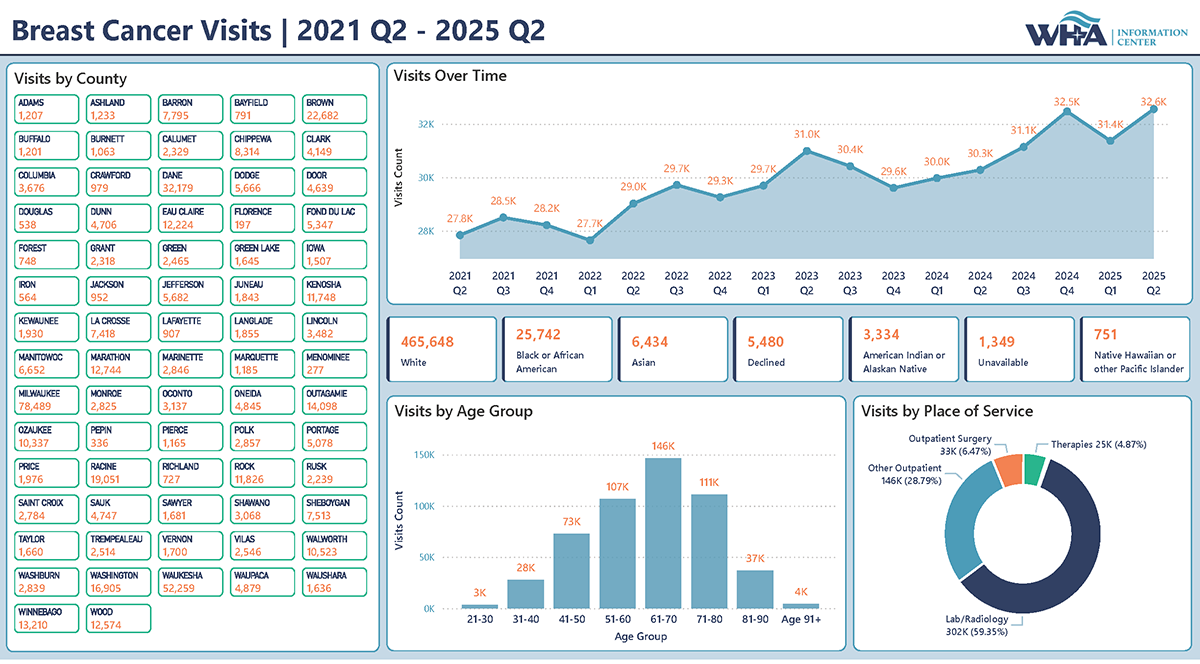Click here to view past issues
IN THIS ISSUE
- Matching Grants Support Shovel-Ready Building Projects Including Clinics and Health Centers
- Time is Running Out – Register Today for the 2026 WHA Health Care Leadership Academy
- Wisconsin Hospitals State PAC & Conduit Enters Final Quarter of Annual Campaign
- 2025 WHA Foundation Global Vision Community Partnership Award Winners Announced
- Free Substance Use Disorders (SUD) Management Boot Camp
- Fast Facts from the WHA Information Center: October is Breast Cancer Awareness Month
EDUCATION EVENTS
Jan. 14, 2026
Caring for Wisconsin’s Caregivers Well-Being First Champion Challenge for Credentialing KickoffJan. 28, 2026
2026 WHA Health Care Leadership AcademyFeb. 25, 2026
2026 Advocacy DayClick here to view education event calendar
View more issues of The Valued Voice
Sign Up for WHA's Newsletter
Fast Facts from the WHA Information Center: October is Breast Cancer Awareness Month
According to the National Breast Cancer Foundation, almost 371,000 women will be diagnosed with invasive breast cancer in the United States in 2025 and one in eight women will be diagnosed in her lifetime. Second to skin cancer, breast cancer is the most diagnosed form of cancer in women. It is also the second leading cause of cancer death in women. According to the National Cancer Institute, the rate of invasive breast cancer (per 100,000 women) in Wisconsin is 133 cases. There are roughly 3.8 million breast cancer survivors living in the United States. And while it is rare, men can also be affected by breast cancer. In 2025, it is estimated that almost 2,800 men in the U.S. will be diagnosed with the disease.
The WHA Information Center analyzed data from January 2021 to January 2025 for breast cancer visits. The age category with the highest number of visits is 61-70 years old. Most patients were seen in outpatient lab and radiology (OLR). Milwaukee County has the highest number of visits, followed by Waukesha County.
Below are some common myths about breast cancer from the National Breast Cancer Foundation:
- Myth: Finding a lump in your breast means that you have breast cancer.
Truth: Only a small percentage of breast lumps turn out to be cancer. But if you discover a persistent lump in your breast that is new or notice any changes in breast tissue, it should never be ignored. - Myth: A mammogram can cause breast cancer to spread.
Truth: A mammogram, or x-ray of the breast, currently remains the gold standard for the early detection of breast cancer. Breast compression while getting a mammogram cannot cause cancer to spread. The standard recommendation is an annual mammographic screening for women beginning at age 40. - Myth: If you have a family history of breast cancer, you are likely to develop breast cancer, too.
Truth: While women who have a family history of breast cancer are in a higher risk group, most women who have breast cancer have no family history. Statistically, only about 10% of individuals diagnosed with breast cancer have a family history of this disease. If you have a mother, daughter or sister who developed breast cancer before the age of 50, you should consider some form of breast imaging starting 10 years before the age of your relative’s diagnosis. If you have had a grandmother or aunt who was diagnosed with breast cancer, your risk increases slightly, but not as much as those who have a first degree relative with breast cancer.
Fast Facts from the WHA Information Center: October is Breast Cancer Awareness Month
According to the National Breast Cancer Foundation, almost 371,000 women will be diagnosed with invasive breast cancer in the United States in 2025 and one in eight women will be diagnosed in her lifetime. Second to skin cancer, breast cancer is the most diagnosed form of cancer in women. It is also the second leading cause of cancer death in women. According to the National Cancer Institute, the rate of invasive breast cancer (per 100,000 women) in Wisconsin is 133 cases. There are roughly 3.8 million breast cancer survivors living in the United States. And while it is rare, men can also be affected by breast cancer. In 2025, it is estimated that almost 2,800 men in the U.S. will be diagnosed with the disease.
The WHA Information Center analyzed data from January 2021 to January 2025 for breast cancer visits. The age category with the highest number of visits is 61-70 years old. Most patients were seen in outpatient lab and radiology (OLR). Milwaukee County has the highest number of visits, followed by Waukesha County.
Below are some common myths about breast cancer from the National Breast Cancer Foundation:
- Myth: Finding a lump in your breast means that you have breast cancer.
Truth: Only a small percentage of breast lumps turn out to be cancer. But if you discover a persistent lump in your breast that is new or notice any changes in breast tissue, it should never be ignored. - Myth: A mammogram can cause breast cancer to spread.
Truth: A mammogram, or x-ray of the breast, currently remains the gold standard for the early detection of breast cancer. Breast compression while getting a mammogram cannot cause cancer to spread. The standard recommendation is an annual mammographic screening for women beginning at age 40. - Myth: If you have a family history of breast cancer, you are likely to develop breast cancer, too.
Truth: While women who have a family history of breast cancer are in a higher risk group, most women who have breast cancer have no family history. Statistically, only about 10% of individuals diagnosed with breast cancer have a family history of this disease. If you have a mother, daughter or sister who developed breast cancer before the age of 50, you should consider some form of breast imaging starting 10 years before the age of your relative’s diagnosis. If you have had a grandmother or aunt who was diagnosed with breast cancer, your risk increases slightly, but not as much as those who have a first degree relative with breast cancer.
IN THIS ISSUE
- Matching Grants Support Shovel-Ready Building Projects Including Clinics and Health Centers
- Time is Running Out – Register Today for the 2026 WHA Health Care Leadership Academy
- Wisconsin Hospitals State PAC & Conduit Enters Final Quarter of Annual Campaign
- 2025 WHA Foundation Global Vision Community Partnership Award Winners Announced
- Free Substance Use Disorders (SUD) Management Boot Camp
- Fast Facts from the WHA Information Center: October is Breast Cancer Awareness Month


